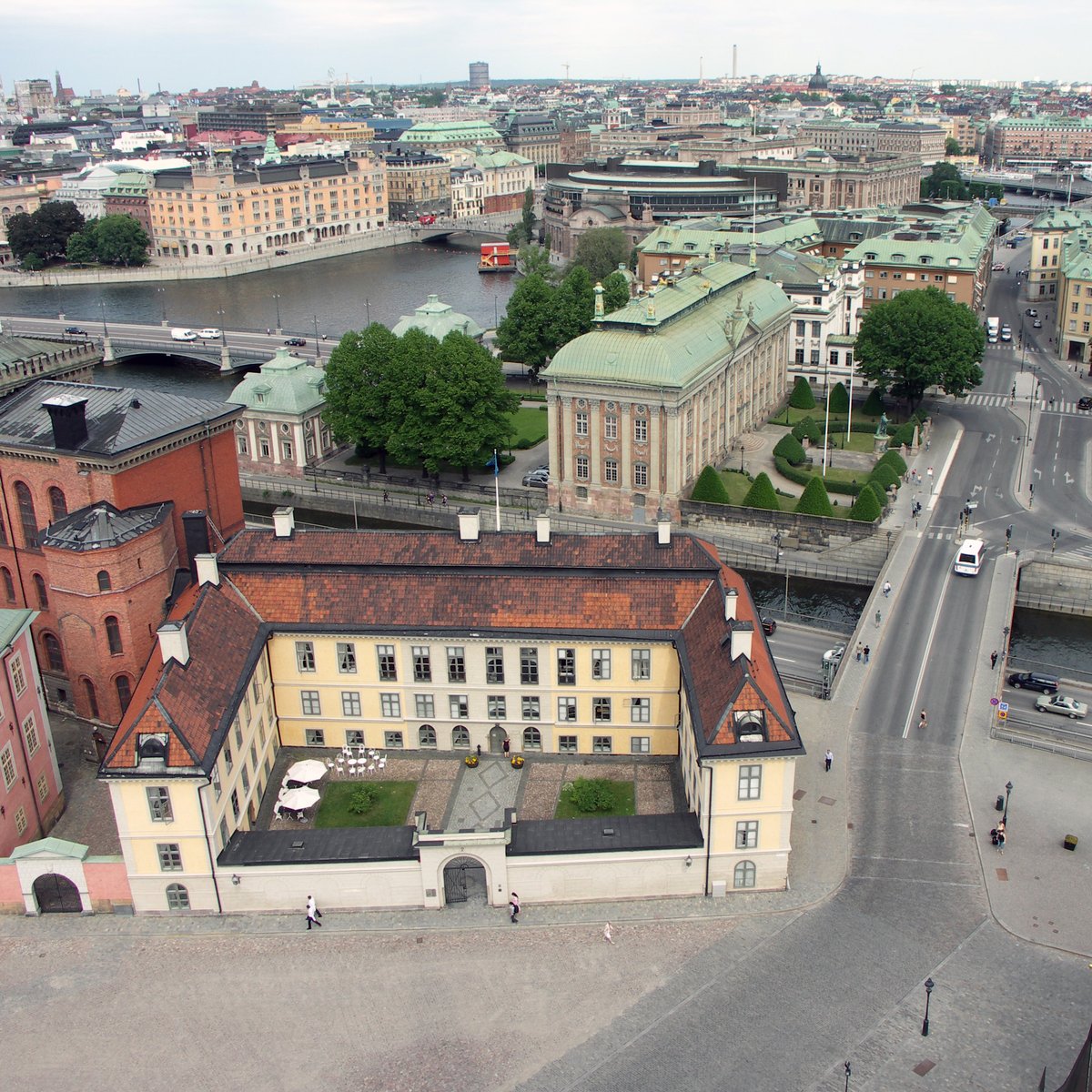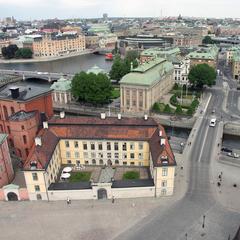
Hessensteinska Palatset Visiting Hours, Tickets, and Stockholm Historical Sites Guide
Date: 14/06/2025
Introduction
Nestled on Stockholm’s picturesque Riddarholmen island, Hessensteinska Palatset—also known as Hessenstein Palace or Bengt Oxenstierna’s Palace—stands as a distinguished emblem of Sweden’s 17th-century aristocratic past and architectural heritage. Commissioned in the 1630s by diplomat Bengt Bengtsson Oxenstierna, the palace reflects the fusion of German-Dutch Renaissance and French château styles, later enhanced with Rococo and Gustavian interiors. Today, it primarily serves as the seat of the Svea Court of Appeal, limiting interior public access, but its grand exterior and prime location near Stockholm’s Old Town make it a highlight for history and architecture enthusiasts.
This guide provides essential information for visiting Hessensteinska Palatset: historical context, hours, ticketing, accessibility, photography tips, and recommendations for exploring nearby historical sites. For current updates on events and tours, refer to the Swedish National Property Board and Svea Court of Appeal websites.
Table of Contents
- Historical Overview
- Visiting Hessensteinska Palatset: Practical Information
- Nearby Attractions and Experiences
- Visuals and Media
- FAQ
- Conclusion
- References
Historical Overview
Origins and Early Ownership
Hessensteinska Palatset was constructed in the 1630s during Sweden’s “Stormaktstiden” (Age of Greatness), a period marked by the nation’s ascent as a European power. The palace was built for Bengt Bengtsson Oxenstierna, a prominent diplomat whose extensive travels influenced the building’s design and cosmopolitan flair. The Oxenstierna family, major players in Swedish politics and society, owned the land since the 16th century.
Architectural Significance
The palace is a notable example of German-Dutch Renaissance architecture with French château elements, featuring volute gables, a high saddle roof, and a distinctive stair tower. Its 18th-century interior renovations introduced Rococo and Gustavian styles, showcasing the evolution of Swedish taste and craftsmanship. The palace’s balanced façade, decorative stonework, and grand entrance reflect the ambitions of the Swedish aristocracy. It is part of a unique ensemble of noble residences on Riddarholmen (Skapa Konst).
Notable Residents and Events
After Oxenstierna’s death, the palace passed through several prominent owners and underwent updates by architects like Nicodemus Tessin the Elder. In 1731, King Fredrik I purchased the property and gifted it to Countess von Hessenstein. Over time, it was repurposed for governmental use and narrowly avoided demolition thanks to preservation efforts. Today, it houses the Svea Court of Appeal, Sweden’s oldest appellate court (Svea hovrätt: Historia).
Visiting Hessensteinska Palatset: Practical Information
Visiting Hours
- Exterior: Accessible year-round, any time of day.
- Interior: Not open for regular public visits due to its function as a court. Interior access is available only during special events or guided tours announced by official sources.
Tickets and Entrance Fees
- Exterior Viewing: Free of charge.
- Guided Tours/Special Events: May require tickets; prices and availability are event-specific. Check the Swedish National Property Board and Svea Court of Appeal for updates.
Accessibility
Located at Birger Jarls torg 2, Riddarholmen, the palace is easily reachable by foot from Stockholm’s Old Town (Gamla Stan) and via the Gamla Stan metro station (Green and Red lines). Riddarholmen is pedestrian-friendly, though cobblestone streets may present challenges for those with mobility impairments. Accessibility accommodations are limited due to the building’s age and function.
Guided Tours and Special Events
Occasionally, the palace opens its interiors for guided tours or cultural events, offering rare glimpses into its Rococo and Gustavian rooms. Tours may be included in larger walking tours of Riddarholmen or scheduled during heritage days. Advance booking is recommended for these limited opportunities.
Photography Tips
- The yellow-plastered façade, elegant Renaissance details, and dramatic light angles make the palace an excellent subject for photography.
- Optimal times for photos are early morning or late afternoon.
- Respect the court’s working environment—do not photograph inside during official functions unless permitted.
Nearby Attractions and Complementary Experiences
Riddarholmen offers a rich context for exploring Stockholm’s history:
- Riddarholmskyrkan: Burial church of Swedish monarchs.
- Gamla Stan: Stockholm’s medieval Old Town, with major sites like the Royal Palace and Stortorget.
- Other Riddarholmen Palaces: Wrangelska, Schering Rosenhanes, and Stenbockska palaces, all part of the noble landscape.
- Scenic Walks: Waterfront views and tranquil courtyards make the island ideal for strolls and photography (Genspark: Riddarholmen).
Visuals and Media
Exterior view of Hessensteinska Palatset showcasing Baroque architecture in Stockholm.
Virtual tours and additional images can be found on the Swedish National Property Board website.
Frequently Asked Questions (FAQ)
Q: Can I visit the interior of Hessensteinska Palatset?
A: Interior access is not routinely available but may be possible during special guided tours or events.
Q: What are the visiting hours?
A: The palace exterior can be viewed at any time; interior access is event-based.
Q: Is there an entrance fee?
A: No fee for exterior viewing; special tours or events may require paid tickets.
Q: How do I get there?
A: Located on Riddarholmen, a short walk from Gamla Stan and near the metro.
Q: Are guided tours available?
A: Occasionally, especially during cultural events or heritage days.
Q: What other sites should I visit nearby?
A: Riddarholmskyrkan, Gamla Stan, the Royal Palace, and other noble palaces on Riddarholmen.
Conclusion
Hessensteinska Palatset is a testament to Sweden’s Age of Great Power, blending aristocratic grandeur with judicial legacy. Its architectural splendor and position amidst Stockholm’s most historic quarters provide a rewarding experience, even without routine interior access. For the best experience, plan your visit around walking tours or special events, and combine your exploration with the island’s other historical gems.
For updates on visiting hours, tickets, and tours, always refer to official resources such as the Swedish National Property Board and Svea Court of Appeal.
Ready to discover more? Download the Audiala app for audio-guided tours, follow us on social media for the latest insider tips, and check out our related guides to Stockholm’s architectural and cultural treasures.
References and External Links
- Swedish National Property Board
- Stockholm Architecture Analysis (Skapa Konst)
- Genspark: Riddarholmen
- Svea Court of Appeal: History
- Travel Notes & Beyond
- Walking Stockholm
- Metrotour Stockholm
- Nordic Visitor: Things to See & Do in Stockholm
- Global Highlights: Sweden Weather in June
- Audiala app





































































































































































